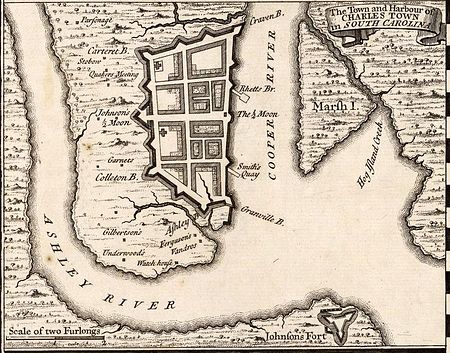Johann David Schöpf/Schoepf, (1752-1800) był lekarzem, zoologiem i botanikiem. Urodził się w Bayreuth. W 1777 roku pojechał do Nowego Jorku jako główny chirurg regimentu Ansbach, najemnej armii heskij w słuzbie brytyjskiej. Podczas wojny z kolonistami stacjonował w Rhode Island. Po wojnie podróżował po USA, Brytyjskiej Wschodniej Florydzie i Bahamach, przez dwa lata. Do Europy wrócił w 1784 roku. Obserwacje, głównie przyrodnicze, ale także społeczne zawarł w dziele pt.: Reisen durch einige der mittleren und südlichen vereinigten nordamerikanischen Staaten nach Ostflorida und den Bahamainseln, unternommen in den Jahren 1783 und 1784 ), przełozonych na angielski jako: Travels in the Confederation (1783–1784) dopiero w 1911 roku. Oto fragment, w którym Niemiec opowiada o tym jak dotarł do Charleston po błotnistej drodze z Wilmington:
„… Charleston to jedno z najwspanialszych amerykańskich miast, nie ustępuje żadnemu z wyjatkiem Filadelii, i nie wiem, czy wobec wspaniałego planu, nie jest równe Filadelfii rozmiarem i populacją. Miasto posiada wiele budynków zbudowanych ze smakiem, głównie z drewna, co jest tłumaczone brakiem zasobów kamienia w regionie. Ale wydaje się, że nie ma powodu, dla którego nie możnaby tu stosować cegły tak często jak w Filadelfii czy Nowym Jorku, skoro nie ma nigdzie więcej i lepszej gliny. Ocenia się, że miasto posiada jakieś 1500 budynków. Szczególna uwagę zwraca się na przewiewne i chłodne wnętrza. Większość domów ma przestronne podwórka i ogrody, a kuchnia jest zawsze położona w osobnym budynku, zgodnie z typowym zwyczajem prowincji południowych, by uniknąć gorąca i ryzyka pożaru. Główne ulice są szerokie proste i przecinają się pod kątem prostym, ale nie są brukowane, co daje podwójną niedogodność podczas pyłowej i deszczowej pogody. W najdłuższym miejscu miasto ma około mili. Maniery są zupełnie inne niż u mieszkańców pólnocnoamerykańskich miast. Zyskowne plantacje ryżu i indygo dają bogactwo wielu rodzinom, pozwalając na wszystkie uciechy jakie okoliczności i klimat dozwalają. Więcej tu elegancji i kurtuazji niż w miastach północy. Mówiono mi już o tym w Filadelfii, i miano rację. Nie ma tu tej denerwującej bardziej gminnej ciekawości typowej dla północy. Tutejsza grzeczność nie jest jednak sztywna, ani formalna. Najbogatsi wysyłają synów i córki do Europy na wychowanie. Daje to lepszy efekt dobrego wyrafinowanego życia niż kwakierskie zwyczaje Pensylwanii… Mają tu własny teatr, w którym występują wędrowne trupy, ale niestety niedawno spłonął. Podobne nieszczęście spotkało elegancką salę taneczną. Promotorem powstania budynku był francuski maitre tańca…” (Schoepf 1911, vol. II, s. 167-168).
Schoepf wydał w Ameryce dzieło typowo medyczne: Materia medica Americana potissimum regni vegetabilis (1787 Cincinnati, Ohio).
Il. 1733 map of Charleston published by Herman Moll
„…As Charleston grew, so did the community’s cultural and social opportunities, especially for the elite merchants and planters. The first theater building in America was built in Charleston in 1736, but was later replaced by the 19th-century Planter’s Hotel where wealthy planters stayed during Charleston’s horse-racing season (now the Dock Street Theatre, known as one of the oldest active theaters built for stage performance in the United States).[6] Benevolent societies were formed by several different ethnic groups: the South Carolina Society, founded by French Huguenots in 1737; the German Friendly Society, founded in 1766; and the Hibernian Society, founded by Irish immigrants in 1801. The Charleston Library Society was established in 1748 by some wealthy Charlestonians who wished to keep up with the scientific and philosophical issues of the day. This group also helped establish the College of Charleston in 1770, the oldest college in South Carolina, the oldest municipal college in the United States, and the 13th oldest college in the United States…”
https://en.wikipedia.org/wiki/History_of_Charleston,_South_Carolina
„…The city of Charleston, South Carolina was founded in 1670 by English colonists. It was named Charles Town in honor of King Charles II (1660-1685). Soon Charleston was a thriving town and port. The Powder Magazine was built about 1713. However Charleston was vulnerable to attack because of its position on the coast. In 1718 the notorious pirate Edward Teach, better known as Blackbeard blockaded Charleston. His men took several prominent citizens prisoner and Blackbeard demanded medical supplies as a ransom. Nevertheless Charleston flourished during the 18th century. Drayton Hall was built in 1742 and Middleton Place House was built in 1755. St. Michael’s Episcopal Church was built in 1761 and Heyward-Washington House was built in 1772. The College of Charleston was founded in 1770 and The Old Exchange & Provost Dungeon was built in 1771. Charleston Museum was founded in 1773. Then on 12 May 1780 during the War of Independence the British captured Charleston. However the British were forced to withdraw from Charleston on 14 December 1782. In 1783 the name of the city was officially changed to Charleston. Charleston golf club was founded in 1786…”
http://www.localhistories.org/worldcities.html
Pozdrawiam dixielandowo z Poznania!
Piotr Napierała






I’m really impressed together with your writing abilities as well as with
the layout for your blog. Is that this a paid
theme or did you modify it yourself? Either way keep up the nice quality writing, it’s uncommon to see a great blog like this one these
days..
Hi there it’s me, I am also visiting this web site daily, this website is
actually good and the viewers are in fact sharing good
thoughts.